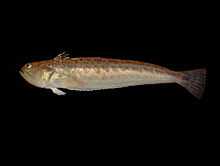Greater weever
| Greater weever | |
|---|---|
 | |
| Scientific classification | |
| Kingdom: | Animalia |
| Phylum: | Chordata |
| Class: | Actinopterygii |
| Order: | Perciformes |
| Suborder: | Trachinoidei |
| Family: | Trachinidae |
| Genus: | Trachinus |
| Species: | T. draco |
| Binomial name | |
| Trachinus draco Linnaeus, 1758 | |
The greater weever (Trachinus draco) is a weever fish of the family Trachinidae. It is less common than the lesser weever.
Description
Its body is a greenish yellow or lime, to dark green and brown, on the head and back, with pale sides, and with yellowish to bluish-brown oblique lines.
The greater weever's body is elongate, tapered and laterally compressed, with a large head. Its length is up to six times its height. The upper rim of the eye has two to three small open spines, in front of each eye.
The mouth is huge and is set obliquely. The eyes are placed toward the top of the head. The dorsal fin is blackish. The second dorsal fin and anal fins have a yellow stripe running their length.
Its pectoral fin is rounded with a notch. On the first dorsal fin, both of the spines, and those of the gill covers, have venom glands attached to them. The spines are grooved, and when pressed, toxin is driven up the grooves.
A male unsexed fish's average size is 53 centimeters (21 in). It weighs about 1.86 kilograms (4.1 lb).

Sting mechanism
The interaction of two muscles (flexor and extensor) attached to the plate opercularis increases the exposed portion of the spine to facilitate the injection of venom. These two muscles are antagonistic, the contraction of one erects the spine, and thus increases its exposed portion such that the membrane surrounding the spine is not elastic, while the contraction of the other reduces the size of the exposed portion. The length of the exposed part of the spine depends on the angle of the opening of the cover.
The outer membrane of the spine presses on the venom gland during the contraction of the flexor muscle, ejecting the venom along the spine.
First aid for stings follows the general pattern for treatment of all weever stings.
Reproduction
Spawning begins in June and August. Pelagic eggs are 1 millimeter (0.039 in). Breeding season is from June to August.
Range and habitat
It inhabits the Eastern Atlantic, in the area 66° N - 27° N, 19° W - 42° E. It ranges from Norway to Morocco, Madeira and the Canary Islands, including the Mediterranean and the Black Seas. It also lives in all waters of the United Kingdom. It prefers a temperate Climate.
The greater weever, like the lesser weever, lives on muddy, sandy or gravelly bottoms, at depths up to about 150 meters (490 ft). It usually rests on the bottom, often with eyes closed, exposing the tip of the first dorsal fin. They feed at night, pelagically, feeding on crustaceans, shrimps and crabs, as well as smaller fish.
Importance to humans
The greater weever has minor commercial importance, and is a gamefish. It can be found in aquariums, mainly those that are public. This weever has medium resilience. The minimum population (that is doubling) time 1.4 to 4.4 years (assuming tm=2-4).
It is eaten fresh or frozen, can be fried, broiled, boiled and baked.
As sport
The UK Record Weights from rod/line from shore as of 2010 is 1 lb-07oz-15dr, and on boat 2 lb-00oz-13dr.
See also
| Wikimedia Commons has media related to Trachinus draco. |
- Weever
- Trachinidae
References
- "Greater Weever". Retrieved 2006-09-22.
|first1=missing|last1=in Authors list (help) - Auerbach, Campbell, P.S., Dr. "Greater Weever Species Summary". Retrieved 2006-09-22.
External links
| |||||||||||||||||||||||||||||||||||||||||||||||||
